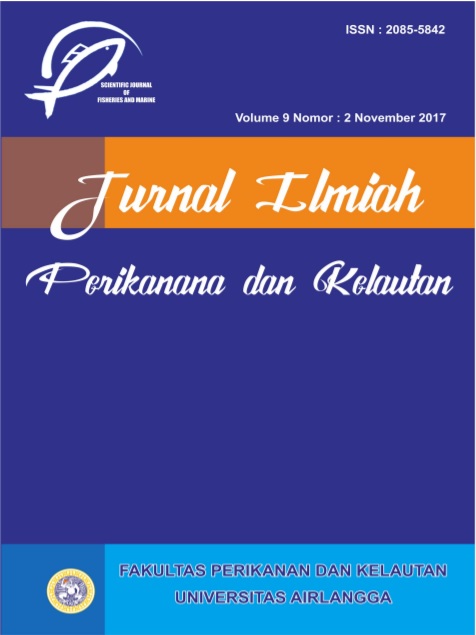Date Log
1. Copyright of the article is transferred to the journal, by the knowledge of the author, whilst the moral right of the publication belongs to the author.
2. The legal formal aspect of journal publication accessibility refers to Creative Commons Atribusi-Non Commercial-Share alike (CC BY-NC-SA), (https://creativecommons.org/licenses/by-nc-sa/4.0/)
3. The articles published in the journal are open access and can be used for non-commercial purposes. Other than the aims mentioned above, the editorial board is not responsible for copyright violation
The manuscript authentic and copyright statement submission can be downloaded ON THIS FORM.
IbM Kelompok Petambak Tradisional Udang Windu Di Desa Kedung Peluk, Yang Menghadapi Penurunan Hasil Panen Secara Drastis Sejak Tahun 1994
[IbM For Windu Shrimp Small Scale Farmer Traditional In Kedung Peluk Village Whose Gets Harvesting Decreased Since 1994 ]
Corresponding Author(s) : Gunanti Mahasri
Jurnal Ilmiah Perikanan dan Kelautan,
Vol. 3 No. 2 (2011): JURNAL ILMIAH PERIKANAN DAN KELAUTAN
Abstract
Abstract
Tiger shrimp (Penaeus monodon Fab) is one of the economically important shrimp, until 1992 became the most important of non petroleum export commodity from fishery sector. Since the end of 1993 up to now, the Penaeus monodon Fab death level has been relatively high and due to this circumstance have been caused many ponds collapsed so that the shrimp production was dramatically declined for year by year. Candi District is one of the Sidoarjo Region areas which have big fisheries potential, aspecially for the breakist water pond, that the topest as the other district. There are a lot of shrimp dead cases until now. But, so that 80% of breakist water pond were broken and not operational. The objective of this societies service activities is applicated a new shrimp culture technology with traditional plus Imuno-Biocirculation System. Imuno-Biocirculation System (SIBR) for increases the shrimp harvest at Candi District Region of Sidoarjo, at June until November 2011. The method using in the activity were socialitation/counseling, dempond and guiding to application of the SIBR model in one periode. Monitoring and evaluation about this result were done in one month after the activity ending. This result showed that a positive indication. There was the knowledges of the farmer in ceases by socialization, it also applicated a model in the right method for shrimp culture. There were also showed that the SIBR model can in ceased the shrimp harvest from 272,43 kg/ha to 854,66 kg/ha, it means was increased 313%. The conclution of this activity is the SIBR model can increased the shrimp harvest and can applicates in more larges area in Sidoarjo Region.
Keywords
Download Citation
Endnote/Zotero/Mendeley (RIS)BibTeX
- Chifumi, Thongchai, Osamu & Kurokura, 2005. Incentive to shifts in Water management systems by shrimp culturist in Shouthern Thailand, Fisheries Science, Vol 71, Issue 4, Pages 791-8
- German, M, Eduardo U, Gasper S & Elizabeth V.B, 2008. A Comparison of Larval production of the Nothern scallop, Argopertempurpuratus, in closed and recirculating Culture system, J.Aquaeng, Vol 38, 11.004.
- Haryanti. 2004. Broodstock Udang Vannamei. Makalah pada Seminar Sehari Perudangan Nasional: Upaya Mengatasi Problem Teknis dan Pemasaran Udang Melalui Standarisasi Budidaya.
- Mahasri,G, 2007. Kemampuan ikan Bandeng sebagai Filter Biologi dalam Menekan Pertumbuhan Ciliata Patogen pada Tambak, LPPM Universitas Airlangga, Surabaya
- Moss, S. M. and S. M. Arce. 2003. SPF Defined: Pathogen – Free Status of Shrimp Limited. Global Aquaculture Advocate.
- Rosati, R, 1994, Indonesian Shrimp Industry Status and Development Project, Puslitbang Perikanan, Jakarta
- Rukyani, A, 1994, Jenis Penyakit Udang, Makalah Pertemuan Aplikasi Paket Teknologi Pertanian, BIP Lampung, 9 – 11 Januari 1994.
- Subandriyo, 2001, Budidaya Udang dengan Sistem Resirkulasi dan Masalahnya, PT. Charoen Pokphand Indonesia, Medan.
- Supito, A. Taslihan dan M. Murdjani. 2004. Solusi Pencegahan White Spot pada Pembesaran Udang Windu di Tambak Sidoarjo dan Gresik Dengan Penerapan BMP Balai Besar Pengembangan Budidaya Air Payau
- Wu Xiongfei & Z. Zhidong, 2005. Closed recirculating system for shrimp-moluscha polyculture, J.oceano-limno, Vol 24 No 4 : 461-8
- Yoram, A, 2006. Biofilters : The need for a new Comprehensive Approach, J.Aquaeng, Vol 34 : 172-8
References
Chifumi, Thongchai, Osamu & Kurokura, 2005. Incentive to shifts in Water management systems by shrimp culturist in Shouthern Thailand, Fisheries Science, Vol 71, Issue 4, Pages 791-8
German, M, Eduardo U, Gasper S & Elizabeth V.B, 2008. A Comparison of Larval production of the Nothern scallop, Argopertempurpuratus, in closed and recirculating Culture system, J.Aquaeng, Vol 38, 11.004.
Haryanti. 2004. Broodstock Udang Vannamei. Makalah pada Seminar Sehari Perudangan Nasional: Upaya Mengatasi Problem Teknis dan Pemasaran Udang Melalui Standarisasi Budidaya.
Mahasri,G, 2007. Kemampuan ikan Bandeng sebagai Filter Biologi dalam Menekan Pertumbuhan Ciliata Patogen pada Tambak, LPPM Universitas Airlangga, Surabaya
Moss, S. M. and S. M. Arce. 2003. SPF Defined: Pathogen – Free Status of Shrimp Limited. Global Aquaculture Advocate.
Rosati, R, 1994, Indonesian Shrimp Industry Status and Development Project, Puslitbang Perikanan, Jakarta
Rukyani, A, 1994, Jenis Penyakit Udang, Makalah Pertemuan Aplikasi Paket Teknologi Pertanian, BIP Lampung, 9 – 11 Januari 1994.
Subandriyo, 2001, Budidaya Udang dengan Sistem Resirkulasi dan Masalahnya, PT. Charoen Pokphand Indonesia, Medan.
Supito, A. Taslihan dan M. Murdjani. 2004. Solusi Pencegahan White Spot pada Pembesaran Udang Windu di Tambak Sidoarjo dan Gresik Dengan Penerapan BMP Balai Besar Pengembangan Budidaya Air Payau
Wu Xiongfei & Z. Zhidong, 2005. Closed recirculating system for shrimp-moluscha polyculture, J.oceano-limno, Vol 24 No 4 : 461-8
Yoram, A, 2006. Biofilters : The need for a new Comprehensive Approach, J.Aquaeng, Vol 34 : 172-8
